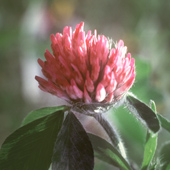
Red Clover
Introduction
This fact sheet provides basic information about the herb plant or part of a plant used for its flavor, scent, or potential therapeutic properties. Includes flowers, leaves, bark, fruit, seeds, stems, and roots. red clover-common names, uses, potential side effects, and resources for more information. Like peas and beans, red clover belongs to the family of plants called legumes. Red clover contains phytoestrogens-compounds similar to the female hormone estrogen.Common Names
red clover, cow clover, meadow clover, wild cloverLatin Names
Trifolium pratenseWhat It Is Used For
- Historically, red clover has been used for cancer and respiratory problems, such as whooping cough, asthma, and bronchitis.
- Current uses of red clover are for menopausal symptoms, breast pain associated with menstrual cycles, high cholesterol, osteoporosis, and symptoms of prostate enlargement.
How It Is Used
The flowering tops of the red clover plant are used to prepare extracts available in tablets and capsules, as well as in teas and liquid forms.What the Science Says
- Although several small studies of red clover for menopausal symptoms had mixed results, a large study found that red clover had no beneficial effects on menopausal symptoms.
- There is not enough scientific evidence to determine whether red clover is effective for any other health conditions.
- NCCAM is studying red clover to learn more about its active components and how they might work in the body, including a clinical trial investigating the safety and effectiveness of red clover for menopausal symptoms.
Side Effects and Cautions
- Red clover seems to be safe for most adults when used for short periods of time. No serious adverse effects have been reported.
- Because red clover contains estrogen-like compounds, there is a possibility that its long-term use would increase the risk of women developing cancer of the lining of the uterus. However, studies to date have been too brief (less than 6 months) to evaluate whether red clover has estrogen-like effects on the uterus.
- It is unclear whether red clover is safe for women who are pregnant or breastfeeding, or who have breast cancer or other hormone-sensitive cancers.
- Tell your health care providers about any complementary and alternative practices you use. Give them a full picture of what you do to manage your health. This will help ensure coordinated and safe care.
Sources
- Red clover. Natural Medicines Comprehensive Database Web site. Accessed on July 5, 2006.
- Red clover (Trifolium pratense). Natural Standard Database Web site. Accessed on July 3, 2007.
- Fugh-Berman A, Kronenberg F. Red clover (Trifolium pratense) for menopausal women: current state of knowledge. Menopause. 2001;8(5):333-337.
- Tice JA, Ettinger B, Ensrud K, et al. Phytoestrogen supplements for the treatment of hot flashes: the Isoflavone Clover Extract (ICE) study. Journal of the American Medical Association. 2003;290(2):207-214.
- Red clover (Trifolium pratense). In: Coates P, Blackman M, Cragg G, et al., eds. Encyclopedia of Dietary Supplements. New York, NY: Marcel Dekker; 2005:587-602.
- NCCAM National Institutes of Health






